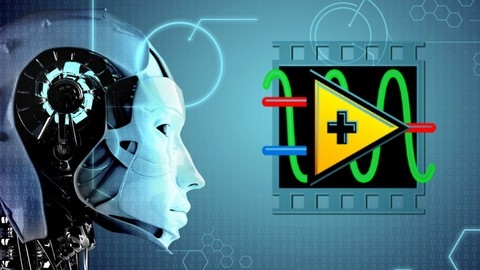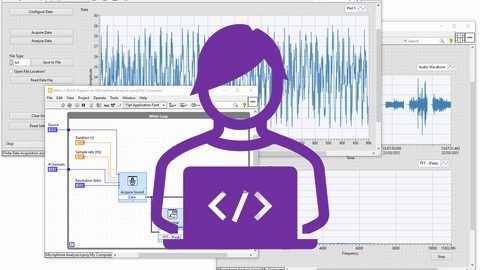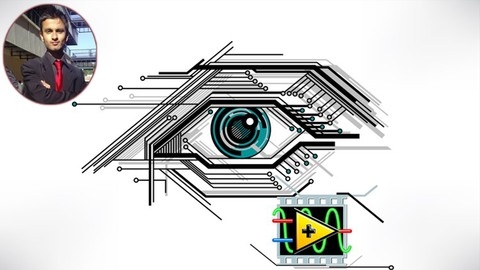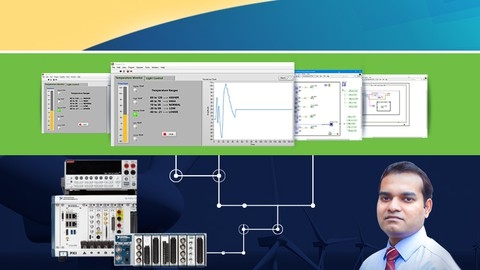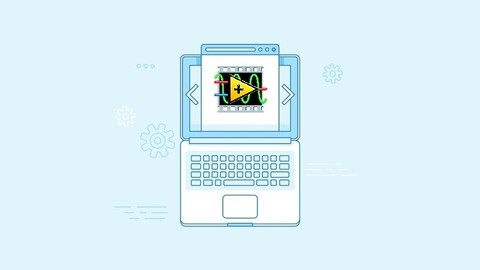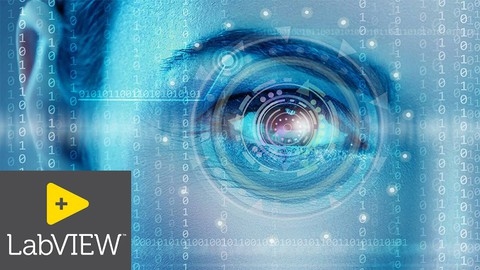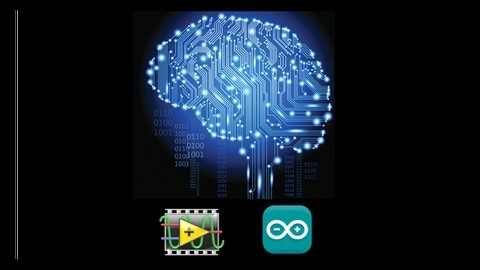LabVIEW, short for Laboratory Virtual Instrument Engineering Workbench, is a powerful graphical programming language commonly used in engineering and scientific applications.
It allows users to create custom applications by connecting visual blocks, simplifying complex processes and fostering intuitive understanding.
Learning LabVIEW can be a valuable asset for anyone working with data acquisition, instrumentation control, or automation tasks.
You’ll be able to build intuitive user interfaces, program data acquisition systems, and develop sophisticated applications for a wide range of industries, from aerospace to biomedical research.
Finding the right LabVIEW course on Udemy can be a daunting task, with so many options available.
You’re looking for a course that’s comprehensive, engaging, and taught by experts.
You also want a program that fits your learning style and goals, whether you’re a complete beginner or already have some experience.
For the best LabVIEW course overall on Udemy, we recommend Complete learning of Labview in 8 hours.
This course dives deep into the core concepts of LabVIEW programming, providing a solid foundation for anyone looking to master this powerful software.
It covers everything from the basics of data types and program flow to advanced topics like SubVIs and file manipulation.
The course is also structured in a way that makes learning enjoyable and effective, with clear explanations, engaging exercises, and a focus on practical applications.
While this is our top pick, we have other great options available, tailored to different learning levels and specific areas of LabVIEW.
Keep reading to explore our recommendations and find the perfect LabVIEW course for you.
Complete learning of Labview in 8 hours
This course dives deep into the core concepts of LabVIEW programming, providing a solid foundation for anyone looking to master this powerful software.
You’ll begin by understanding the fundamental building blocks of a LabVIEW program, including the front panel, block diagram, and the diverse toolkit available.
The syllabus expertly guides you through data types, including numeric, boolean, strings, and arrays.
You’ll learn the intricacies of array manipulation, exploring operations and functions specifically designed for this data structure.
This course goes beyond the basics, teaching you how to control program flow with structures and loops.
You’ll gain proficiency in using while loops, for loops, and case structures.
The comprehensive approach extends to timing blocks and shift registers, equipping you with the tools to optimize program execution.
The curriculum delves into working with files and reports, covering a wide range of operations from creating and accessing files to reading and writing data in various formats.
You’ll master techniques for working with text files, spreadsheets, and even word processing documents.
Finally, you’ll explore advanced features like express blocks and dialog blocks, designed to create intuitive user interfaces and simplify your programming workflow.
You’ll also learn about SubVIs, reusable program segments that promote modularity and efficiency in your LabVIEW projects.
With this comprehensive and well-structured course, you’ll be well-equipped to tackle a wide range of LabVIEW programming challenges.
The Ultimate LabView 2020 Course
This comprehensive LabVIEW course takes a hands-on approach, starting with the fundamentals and gradually building towards advanced concepts.
You’ll dive straight into the LabVIEW environment, mastering its interface, data types, and data flow principles.
You’ll learn to write clean, efficient code by adopting best practices, and put those skills to the test through engaging exercises, like programming a circle, and debugging scenarios that will teach you how to identify and fix broken VIs.
Next, you’ll explore the power of structures and loops, gaining proficiency with the “while,” “for,” and “case” structures.
You’ll learn how to use timers within loops and utilize shift registers to manage data flow effectively.
Strengthen your understanding through quizzes and apply your knowledge to practical projects like developing a Rock Paper Scissors game.
Moving on, you’ll delve into the world of arrays, learning how to create, access, and manipulate them, essential skills for working with data in LabVIEW.
You’ll also master text file manipulation, creating, accessing, writing, and reading them, further expanding your data handling capabilities.
The course then focuses on Sub VIs, reusable blocks of code that enhance modularity and efficiency in your LabVIEW projects.
You’ll also explore the use of property nodes, gaining control over object properties within your programs.
These skills are critical for building robust and scalable LabVIEW applications.
The course culminates in a final project where you’ll design a bank system application.
You’ll use simulated NI-Hardware to acquire data, providing practical experience relevant to real-world applications.
This final project will solidify your understanding of LabVIEW concepts and techniques, equipping you with the skills needed to tackle a variety of programming challenges.
The Complete LabVIEW Essentials - Code & Acquire Data Now
This course provides a solid foundation in LabVIEW, a powerful programming language commonly used in engineering and scientific applications.
You’ll start by understanding the basics of LabVIEW, its purpose, and how to set up your development environment.
You’ll then delve into the core concepts of LabVIEW, exploring the front panel, block diagram, and the crucial role of data flow in your code.
The course doesn’t shy away from essential programming constructs like decision making, loops, and error handling.
You’ll learn how to implement these concepts using structures like case structures and while loops, enabling you to create more sophisticated applications.
You’ll also learn to interact with hardware through LabVIEW, covering data acquisition using NI DAQ devices and interacting with other instruments.
The final sections focus on building comprehensive applications.
You’ll learn to organize your code, create user-friendly interfaces, manage data files, and even build standalone executables.
You’ll also explore the VI Server, a powerful feature allowing you to programmatically control the LabVIEW user interface.
Learn Computer Vision and Image Processing in LabVIEW
This LabVIEW course offers a comprehensive journey into the world of computer and machine vision, guiding you from the fundamentals of image processing to more advanced concepts like object tracking.
You’ll start by learning how to acquire images from your camera and manipulate them using LabVIEW’s powerful vision tools.
The course dives deep into color processing, equipping you with techniques like color segmentation and tracking, and you’ll even build an application to count colorful M&Ms in an image, making the learning process both engaging and practical.
You’ll then transition into the fascinating realm of feature detection.
You’ll learn to identify blobs, edges, and lines using LabVIEW’s intuitive vision assistant, building a coin detection app along the way.
You’ll also explore a lane detection algorithm, gaining hands-on experience with real-world applications.
The course then delves into more advanced feature detection techniques, including template matching, optical flow, and optical character recognition (OCR), allowing you to learn how to track objects, recognize barcodes, and even extract text from images.
Throughout the course, you’ll have opportunities to solidify your knowledge through a series of exercises and a quiz.
The course concludes with a valuable bonus section, offering additional resources to deepen your understanding.
You’ll explore a vehicle detection framework, a journal article on image processing using LabVIEW, and learn the fundamentals of the Kalman filter using a fun example of Pokemon.
This course provides a strong foundation in LabVIEW computer vision and machine vision, equipping you with the skills to tackle a variety of real-world applications.
Whether you’re a professional engineer or a curious learner, this course offers a valuable learning experience that will open doors to exciting possibilities in the field of image processing.
NI LabVIEW: Become a LabVIEW Test Engineer
This “NI LabVIEW: Become a LabVIEW Test Engineer” course offers a comprehensive exploration of graphical programming, specifically within the LabVIEW environment.
You’ll begin by understanding LabVIEW’s role in engineering and the career opportunities available for LabVIEW professionals.
The course then guides you through setting up LabVIEW 2014 Home Edition, an ideal environment for learning and experimentation.
You’ll quickly dive into the core concepts of LabVIEW, learning about virtual instruments, the power of the palette, and the fundamental principles of wiring.
The syllabus then guides you through essential data types such as numerics, strings, and Booleans, emphasizing practical manipulation techniques.
You’ll develop a strong understanding of the Front Panel and Block Diagram, crucial components for designing user interfaces and implementing program logic.
You’ll master important control structures like the Case Structure and various loops (for, while, infinite while), empowering you to handle complex decision-making processes and iterations.
The course delves into advanced concepts such as arrays, clusters, and timings, enabling you to manage data structures efficiently.
You’ll learn to create subVIs for modular programming, enhancing code organization and reusability.
Additionally, the syllabus covers essential graphical tools like Waveform Graph and XY Graph, along with fundamental file operations for data management.
The course then delves into the world of data acquisition with NI DAQ, covering both foundational and advanced concepts.
You’ll learn to leverage the DAQ Assistant for digital and analog I/O, and explore the robust NI MAX interface for hardware management.
Through practical industrial model projects, such as LED brightness control, temperature sensing, and relay cluster sequencing, you’ll gain experience applying your knowledge to real-world scenarios.
You’ll also venture into serial port programming and discover the possibilities of DLL calling for integrating external code into LabVIEW projects.
The course culminates with the Application Builder, allowing you to create executable files from your LabVIEW projects, ultimately bringing your creations to life.
The Complete Beginner’s guide to LabView Programming
This course offers a robust introduction to Labview programming, starting with the fundamentals and building towards more advanced concepts.
You’ll begin by understanding the Labview environment, how to create Virtual Instruments (VIs), and the core concept of data flow programming.
The course dives into data types, providing you with the building blocks for your Labview programs, and equips you with essential debugging skills for identifying and resolving errors in your code.
You’ll then gain hands-on experience by creating your first programs, including a classic “Hello World” and a Celsius-to-Fahrenheit converter.
You’ll learn to create SubVIs, reusable code blocks that improve program organization and efficiency, a key practice in Labview development.
The course moves on to explore loops, allowing you to repeat code sections, and demonstrates how to use charts and graphs to visualize your data effectively.
You’ll learn about local and global variables for data storage and dive into the use of clusters, powerful data structures for organizing related information.
You’ll also gain experience working with time using the Clock Timer, manipulating text using string functions, and understanding the benefits of Shift Registers and Feedback Nodes for data transfer within your programs.
The course introduces the Auto Match VI, a helpful tool for streamlining the connection of program elements.
You’ll then delve into Case Structures, which enable conditional code execution based on different criteria.
The course concludes by exploring advanced features such as Property Nodes and Formula Nodes, providing you with a strong foundation in Labview programming.
Complete LabVIEW Image Processing & Machine Vision Course
This comprehensive course provides a robust introduction to image processing and machine vision using LabVIEW.
You’ll embark on a journey from the fundamentals of image manipulation within LabVIEW, encompassing import, saving, and basic transformations, to the intricacies of camera integration for capturing images and video.
The course dives deep into a wide array of image processing techniques.
You’ll gain proficiency in color detection, histogram analysis, and line profile generation, all essential tools for extracting meaningful information from images.
The exploration extends to operators like IMAQ Add, IMAQ Subtract, and IMAQ AND, allowing you to perform complex image manipulations.
Processing techniques such as IMAQ Inverse and IMAQ Thresholding are expertly explained, equipping you with the skills to refine and enhance image data.
You’ll then delve into the crucial aspects of counting and measuring objects within images, a fundamental task in many machine vision applications.
Morphology, a powerful technique for image enhancement, is thoroughly covered.
You’ll learn how to use techniques like filling holes, rejecting borders, and removing particles to improve the quality and clarity of your images.
Image filtering and edge detection are explored, giving you the ability to isolate specific features and enhance the overall visual information within images.
Searching and matching techniques are presented, allowing you to locate patterns within images, including rotated objects and multiple images.
Tracking objects within video sequences is also explored, a critical skill for numerous real-world applications.
The course utilizes the IMAQ dx library, enabling you to seamlessly integrate cameras into your LabVIEW applications.
Overlay techniques, including text and shapes, are covered, allowing you to visually annotate and enhance your images.
You’ll also learn how to accurately measure distances between objects within images, a valuable capability for various applications.
The course concludes with a practical exploration of Optical Character Recognition (OCR), focusing on license plate recognition.
You’ll learn how to extract text from images, a valuable skill in many fields.
Barcode reading, another essential application of machine vision, is covered, demonstrating how to extract data from barcodes using LabVIEW and a camera.
You’ll be well-equipped to tackle a wide range of tasks, from basic image manipulation to advanced object detection and analysis.
Fuzzy Logic, Labview and Arduino
You’ll start by gaining a solid understanding of the fundamentals of fuzzy logic, including its core concepts and algorithms.
This foundation is then built upon by exploring the design and implementation of fuzzy controllers for various real-world scenarios, such as temperature regulation, water level control, and even the creation of intelligent robotic systems.
The course’s hands-on approach allows you to engage with these concepts directly.
For instance, you’ll delve into the fascinating “nurse robot challenge,” applying fuzzy intelligence to design a care robot capable of responding to its environment.
You’ll also work with the powerful Fuzzy Labview toolkit, a tool designed to simplify the implementation of complex fuzzy logic systems.
Moving beyond theory, the course transitions smoothly to the integration of fuzzy logic with Arduino and Labview.
You’ll learn to bridge the gap between digital logic and the physical world, reading and writing digital and analog signals to control sensors and actuators.
This culminates in the exciting project of building a washer machine with Arduino, providing a real-world application of fuzzy logic principles.
Finally, you’ll delve into the advanced realm of fuzzy self-adaptive PID controllers, exploring their design and implementation for robust control systems that can adapt to dynamic environments.
This course offers a well-rounded approach to fuzzy logic, equipping you with valuable skills that are highly sought after in various industries, including robotics, automation, and intelligent systems.


